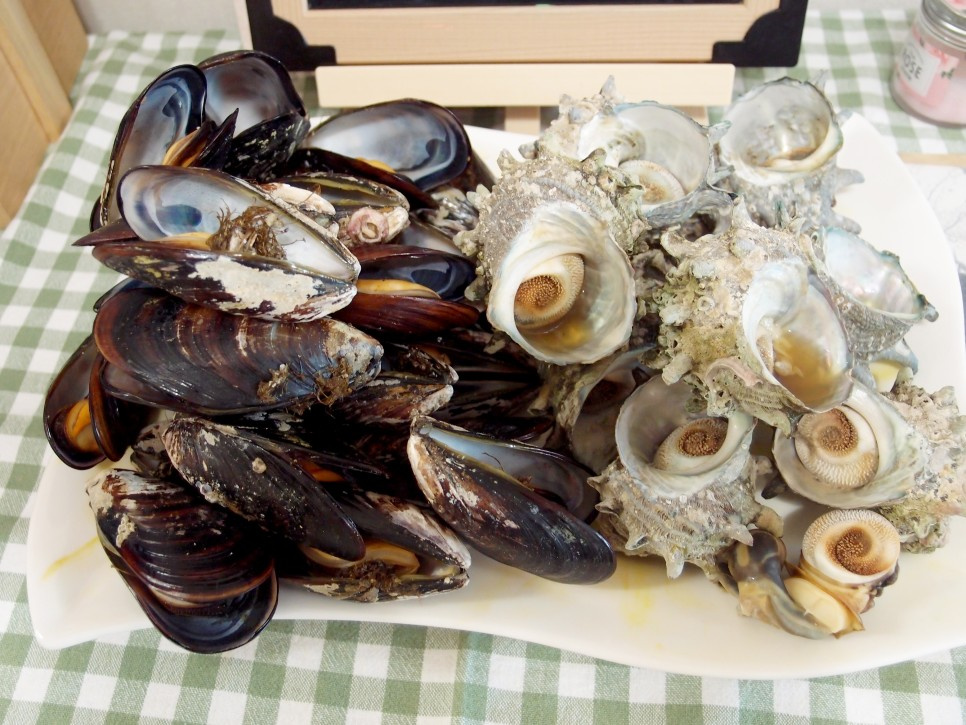Tender & Chewy Steamed Whelk and Natural Mussel (Seop) Delight
#WhelkSteamed #NaturalMusselSteamed #SeopSteamed #ChewySeafoodRecipe #SpicyDippingSauceEssential #FreshIngredients #HomeCooking

Experience the incredible chewy texture of ‘Seop’ (natural mussels) and ‘Whelk’ with this exquisite steamed dish recipe, a culinary gem that even Chef Ahn Jung-hwan marveled at! Unlike common mussels, natural ‘Seop’ boasts a firm shell and plump meat, offering a rich, nutty flavor that intensifies with every chew. The whelk, in particular, provides a depth of flavor and a satisfying chewiness unparalleled by regular conchs. Adding a splash of Cheongju (rice wine) to the steaming process not only eliminates any fishy odor but also enhances the natural sweetness of the seafood. While preparing these treasures might require a bit of effort, the moment you take a bite, their remarkable texture and flavor will make all your hard work melt away. Paired with a spicy gochujang-based dipping sauce (cho-gochujang), this whelk and seop steamed dish is a true culinary delight. Get ready to impress your taste buds!
Ingredients- Whelk 1.5kg
- Natural Mussels (Seop) 30 pcs
- Cheongju (Rice Wine) 2 cups (approx. 400ml)
- Coarse Sea Salt 2 Tbsp
- Cho-gochujang (Spicy Dipping Sauce) 6 Tbsp (for serving)
Cooking Instructions
Step 1
Begin by preparing the whelks. Whelks are named for their horn-like protrusions, indicating their tough exterior. For the first cleaning step, place the whelks in a basin of cold water. Gently rub the shells together, as if they are knocking horns, under running water 3-4 times to remove any external debris.

Step 2
After the initial rinse, place the whelks in a bowl with cold water and add 2 tablespoons of coarse sea salt. Let them purge for about 1 hour. This ‘purging’ process removes any grit or sand from inside the shells, ensuring a cleaner taste. Once purged, rinse them gently again under cold running water, rubbing the shells to ensure they are thoroughly clean.

Step 3
Next, prepare the natural mussels, known as ‘Seop’. These are distinct from common mussels due to their spiky texture and very hard shells, designed for self-protection. Take two ‘Seop’ and rub their shells against each other to remove the barnacles and rough edges. This method is much faster and more effective than using a scrubbing pad. Once both the whelks and the ‘Seop’ are thoroughly cleaned, arrange them in a steamer. Place the whelks in the lower basket and the ‘Seop’ in the upper basket. Pour 2 cups of Cheongju (rice wine) into the steaming water to eliminate any potential fishy odors and enhance the seafood’s natural flavor.

Step 4
Steam for about 10-15 minutes. The ‘Seop’ will signal they are cooked by opening their shells. Since they cook faster, remove the ‘Seop’ first. The whelks require slightly longer cooking time, so continue steaming them after removing the ‘Seop’ until they are fully cooked.

Step 5
Carefully take out a cooked ‘Seop’, pry open its shell, and examine the meat. Natural ‘Seop’ might not be as large as common mussels, but their vibrant orange color is visually appealing. The dark threads, often found on mussels, can be trimmed with scissors before eating or pulled off as you consume them. Pulling them off while eating can be quite convenient.

Step 6
Here is the clean, plump meat of the natural mussel (‘Seop’), showcasing its beautiful orange hue that promises a delightful taste. Unlike the tenderness of common mussels, ‘Seop’ is characterized by its wonderfully chewy texture. Dipping these chewy morsels into cho-gochujang is the ultimate way to savor their unique flavor.

Step 7
Finally, the whelks are perfectly steamed! Notice how their dark shells have turned a lighter, grayish color. Extracting whelk meat can be a bit trickier than with regular conchs. The opening of the whelk shell is exceptionally hard, making it difficult to dislodge the meat with standard utensils like chopsticks or toothpicks. The easiest method for removing the whelk meat is by using metal chopsticks. Insert the metal chopstick into the gap between the upper shell and the side of the meat, then gently lever it out. Simply trying to stab the shell directly won’t work effectively. Look for that small opening and use it to your advantage to easily extract the delicious meat.

Step 8
This is the extracted whelk meat, complete with its rich innards. After removing the innards and the hard, ear-like operculum (the part that seals the shell opening), dip the whelk meat into cho-gochujang. The delightfully chewy texture and deep flavor will surely surprise and impress you!

Step 9
The steamed natural mussels (‘Seop’) and the deeply flavorful steamed whelks are now ready! This dish showcases the pure, unadulterated taste of fresh seafood at its finest.




